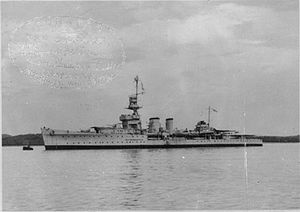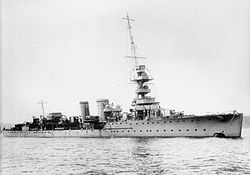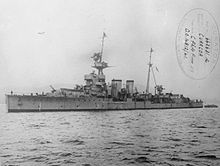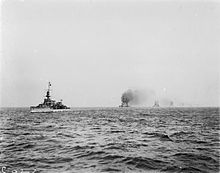- C class cruiser
-
For the Royal Navy third class cruisers of the late nineteenth century, see C class corvette.

HMS CapetownClass overview Name: C-class cruiser Operators:  Royal Navy
Royal NavyPreceded by: Arethusa class Succeeded by: Danae class Subclasses: Caroline
Calliope
Cambrian
Centaur
Caledon
Ceres
CarlisleCompleted: 28 Active: One, HMS Caroline Lost: Seven General characteristics Type: light cruiser Displacement: 4,180 tons (standard)
4,950 tons (full load)Length: 450 ft (140 m) overall Beam: 43 ft (13 m) Draught: 14 ft (4.3 m) Propulsion: 2 shaft Parsons geared turbines
6 boilers
40,000 shpSpeed: 29 knots (54 km/h) Range: 5,900 nautical miles (10,930 km) at 10 knots (20 km/h) Complement: 334 Armament: 5 BL 6-inch (152.4 mm) Mk XII guns (5x1)
8 21-inch (530-mm) torpedo tubes (4x2)
2 QF 3 inch (76-mm) 20 cwt Mk I anti-aircraft guns (2x1)
2 QF 2-pounder (40-mm) anti-aircraft guns (2x1)Armour: machinery spaces: 3 inch sides
magazines: 2¼ inch sides
deck: 1 inchThe C class was a group of twenty-eight light cruisers of the Royal Navy, and were built in a sequence of seven classes known as the Caroline (six ships), Calliope (two ships), Cambrian (four ships), Centaur (two ships), Caledon (four ships), Ceres (five ships) and Carlisle (five ships) classes. They were built for the rough conditions of the North Sea and proved rugged, and capable, vessels, though they were quite small and cramped.
Contents
The Caroline class
The Caroline class were all ordered in July to August 1913, as the first six of eight "light armoured cruisers" under the 1913 programme. They were launched in 1914 or 1915 and commissioned in 1915. They had an armament of two single 6 in guns aft, eight 4 in guns and two 6 pounder guns. Their anti-aircraft (A/A) weaponry consisted of four 3 pounder guns. Their aft 6 in guns were superfiring and the class had three funnels. During the First World War, the ships of the class underwent a variety of alterations, including the removal of the 4-inch (102 mm) guns in Caroline, Carysfort and Comus, being replaced by two extra 6-inch (152 mm) guns, while Cleopatra, Conquest and Cordelia retained one or two of the 4-inch (102 mm) guns, with two 2 pounder guns being added to some of the ships.
Ships
- HMS Caroline, built by Cammell Laird and Company, Birkenhead, laid down 28 January 1914, launched 29 September 1914, and completed December 1914. Became a drill ship for the Royal Navy Volunteer Reserve in April 1924 and still fulfills that role in Alexandra Dock, Belfast.
- HMS Carysfort, built by Pembroke Dockyard, laid down 25 February 1914, launched 14 November 1914, and completed June 1915. Sold for breaking up August 1931.
- HMS Cleopatra, built by Devonport Dockyard, laid down 26 February 1914, launched 14 January 1915, and completed June 1915. Sold for breaking up June 1931.
- HMS Comus, built by Swan Hunter and Wigham Richardson, Wallsend on Tyne, laid down 3 November 1913, launched 16 December 1914, and completed January 1915. Sold for breaking up 28 July 1934.
- HMS Conquest, built by Chatham Dockyard, laid down 3 March 1914, launched 20 January 1915, and completed June 1915. Sold for breaking up 29 August 1930.
- HMS Cordelia, built by Pembroke Dockyard, laid down 21 July 1913, launched 23 February 1914, and completed January 1913. Sold for breaking up 31 July 1923.
The Calliope class
The two ships of the Calliope sub-class - HMS Calliope and HMS Champion - were the last pair of the eight "light armoured cruisers" to be ordered in July to August 1914 under the 1913 Programme. They had all geared turbines, the first RN cruisers to be fitted with them. They also had increased belt armour and, Champion had just two screws. They were commissioned in mid to late 1915, as modifications to the Caroline with higher speeds and a more efficient boiler layout and the reduction in the number of funnels to two. The two ships had different machinery types for comparative purposes. Calliope and Champion underwent similar gun armament modifications to the Caroline class. They also had underwater tubes rather than the deck mounted weapons of the Caroline class and were given two twin deck mounted torpedo tubes during the war but these were later removed to reduce top weight.
Ships
- HMS Calliope: Built by Chatham Dockyard, laid down 1 January 1914, launched 17 December 1914, and completed June 1915. Sold for breaking up 28 August 1931.
- HMS Champion: Built by R. & W. Hawthorn Leslie and Company, Hebburn on Tyne, laid down 9 March 1914, launched 29 May 1915, and completed December 1915. Sold for breaking up 28 July 1934.
The Cambrian class
The Cambrian class were ordered in September 1914 under the 1914-15 Programme, and commissioned between 1915 and 1916. They had two funnels rather than the three in the Caroline class, following on from the developments in the Calliope subclass. The Cambrian class had similar armament to the previous sub-class, with its main armament being four 6-inch (152 mm) guns in single mounts. Their secondary armament consisted of eight 4-inch (102 mm) guns. They were later removed, with Canterbury and Champion retaining one single 4-inch (102 mm) gun. The rest of the ships used either two to three 3-inch (76 mm) guns.
Ships
- HMS Cambrian, built by Pembroke Dockyard, laid down 8 December 1914, launched 3 March 1916, and completed May 1916. Sold for breaking up 28 July 1934.
- HMS Canterbury, built by John Brown and Company, Clydebank, laid down 14 October 1914, launched 21 December 1915, and completed May 1916. Sold for breaking up 28 July 1934.
- HMS Castor, built by Cammell Laird, laid down 28 October 1914, launched 28 July 1915, and completed November 1915. Sold for breaking up 30 July 1936.
- HMS Constance, built by Cammell Laird, laid down 25 January 1915, launched 12 September 1915, and completed January 1916. Sold for breaking up 8 June 1936.
The Centaur class
The Centaur class were ordered in December 1914, and built using materials originally intended for two scout cruisers to be built for Turkey. They were launched and commissioned in 1916. The class also had geared turbines as well as four screws. They retained the two funnels introduced to the C class by the Cambrians. Their main armament was five 6 in guns in single mounts. Their 4-inch (102 mm) guns were mostly replaced in a similar fashion to the previous sub-classes, with smaller calibre guns.
Ships
- HMS Centaur, built by Sir W.G. Armstrong-Whitworth & Co., Ltd., Walker on Tyne, laid down 24 January 1915, launched 6 January 1916, and completed August 1916. Sold for breaking up February 1934.
- HMS Concord, built by Armstrong-Whitworth, laid down 1 February 1915, launched 1 April 1916, and completed December 1916. Sold for breaking up August 1935.
The Caledon class
Class overview Name: Caledon Completed: Four Lost: Two General characteristics Type: C class cruiser Displacement: 4,180 tons (standard), 4,950 tons (full load) Length: 450 ft (140 m) overall Beam: 43 ft (13 m) Draught: 14 ft (4.3 m) Propulsion: 2 shaft Parsons geared turbines
6 boilers
40,000 shpSpeed: 29 knots (54 km/h) Range: 5,900 nautical miles (10,930 km) at 10 knots (20 km/h) Complement: 334 Armament: 5 BL 6-inch (152.4 mm) Mk XII guns (5x1)
8 21-inch (533 mm) torpedo tubes (4x2)
2 QF 3 inch 20 cwt Mk I (2x1)
2 2-pounder guns (2x1)Armour: machinery spaces: 3 inch sides
magazines: 2¼ inch sides
deck: 1 inchThe Caledon class were all ordered in December 1915 and commissioned in 1917. They retained the two funnels of the previous two sub-classes. Their propulsion was slightly different from the previous sub-classes. Their superstructure was also slightly altered. They had a main armament of five 6-inch (152 mm) guns and a secondary armament of two 3 in guns, as well as an AA armament of four 3 pounder guns. The surviving ships of the class survived to see World War II, and underwent a number of modifications. Five Oerlikon 20 mm cannons were added to all ships. Caledon herself had a different armament, as she underwent an extensive rebuild that saw her become an AA cruiser. She was armed with the effective 4-inch (102 mm) gun, of which she had twelve, two 40 mm Bofors and eight 20 mm Oerlikons.
Ships
- HMS Caledon, built by Cammell Laird, laid down 17 March 1916, launched 25 November 1916, and completed March 1917. Became A/A ship in December 1943; sold for breaking up 22 January 1948.
- HMS Calypso, built by Hawthorn Leslie, laid down 7 February 1916, launched 24 January 1917, and completed June 1917. Sunk by Italian submarine Bagnolini south of Crete 12 June 1940.
- HMS Cassandra, built by Vickers, Barrow in Furness, laid down March 1916, launched 25 November 1916, and completed June 1917. Sunk by mine in the Baltic 5 December 1918.
- HMS Caradoc, built by Scott's Shipuilding and Engineering Company, Greenock, laid down 21 February 1916, launched 23 December 1916, and completed June 1917. Became a base ship April 1944, sold for breaking up May 1946.
The Ceres Class
Class overview Name: Ceres Completed: Five Lost: Three General characteristics Type: C class cruiser Displacement: 4290 tons (standard)
5276 tons (full load)Length: 452 ft (138 m) overall Beam: 43.5 ft (13.3 m) Draught: 14 ft (4.3 m) Propulsion: 2 shaft Brown-Curtis geared turbines
6 boilers
40,000 shpSpeed: 29.5 knots (55 km/h) Range: 5,900 nautical miles (10,930 km) at 10 knots (20 km/h)
AA conversions: 3250 nm at 12ktsComplement: 334 Armament: Cardiff & Ceres:
4 2-pounder guns (4x1)
5 BL 6-inch (152.4 mm) Mk XII guns (5x1)
2 QF 3 inch 20 cwt Mk I (2x1)
2 2-pounder guns (2x1)
8 21-inch (533 mm) torpedo tubes (4x2)
Coventry & Curlew (modified 1936)
10 QF 4 inch Mk V guns (10x1)
16 2-pounder guns (2x8)
Curacoa (modified 1939)
8 4 inch Mk XIX (4x2)Armour: machinery spaces: 3 inch sides
magazines: 2¼ inch sides
deck: 1 inchThe Ceres class were ordered in March to April 1916 and commissioned between 1917 and 1918. They were very "wet" at the bow, which was remedied in the subsequent Carlisle sub-class with the addition of a "trawler bow". Their main armament consisted of five 6-inch (152 mm) guns, while their secondary armament consisted of two 3-inch (76 mm) guns, of which a further one was later added to Ceres herself. Four 3 pounder guns were also fitted.
Three ships underwent extensive rebuilds during the 1930s, becoming AA cruisers, resulting in all previous armament being removed. The ships were Coventry, Curacoa and Curlew, with Curacoa being the last of the three to be rebuilt in 1939; the other two ships having been converted in 1935. Coventry and Curlew were given ten 4-inch (102 mm) guns (two later being removed from Coventry) and sixteen 3-inch (76 mm) guns for their AA role. Curacoa had slightly different gun numbers, being armed with eight 4-inch (102 mm) guns and four 3-inch (76 mm) guns, and later on in WWII, four 20 mm Oerlikons. Cardiff and Ceres were to have undergone the same conversion, but this was prevented by the outbreak of war.
Ships
- HMS Cardiff, built by Fairfield Shipbuilding and Engineering Company, Govan, laid down 22 July 1916, launched 12 April 1917, and completed June 1917. Sold for breaking up 23 January 1946.
- HMS Ceres, built by John Brown, laid down 11 July 1916, launched 24 March 1917, and completed June 1917. Sold for breaking up 5 April 1946.
- HMS Coventry, built by Swan Hunter, laid down 4 August 1916, launched 6 July 1917, and completed February 1918. Became A/A ship in 1937; sunk by aircraft off Tobruk in the Mediterranean 14 September 1942.
- HMS Curacoa, built by Pembroke Dockyard, laid down July 1916, launched 5 May 1917, and completed February 1918. Became A/A ship in 1939; sunk in collision with RMS Queen Mary north of Ireland 2 October 1942.
- HMS Curlew, built by Vickers, laid down 21 August 1916, launched 5 July 1917, and completed December 1917. Became A/A ship in 1938; sunk by aircraft in Ofot Fjord, Norway, 26 May 1940.
The Carlisle Class
HMS CarlisleClass overview Name: Carlisle Completed: Five Lost: Two General characteristics Type: C class cruiser Displacement: 4200 tons (standard)
5300 tons (full load)Length: 452 ft (138 m) overall Beam: 43.5 ft (13.3 m) Draught: 14 ft (4.3 m) Propulsion: 2 shaft Parsons (Brown-Curtis in Colombo & Carlisle) geared turbines
6 boilers
40,000 shpSpeed: 29.5 knots (55 km/h) Range: 5,900 nautical miles (10,930 km) at 10 knots (20 km/h) Complement: 334 Armament: Capetown & Colombo:
4 2-pounder guns (1x4)
5 BL 6-inch (152.4 mm) Mk XII guns (5x1)
2 QF 3 inch 20 cwt Mk I (2x1)
2 2-pounder guns (2x1)
8 21-inch (533 mm) torpedo tubes (4x2)
Cairo, Carlisle & Calcutta (as modified 1938/39):
8 4 inch Mk XIX (4x2)Armour: machinery spaces: 3 inch sides
magazines: 2¼ inch sides
deck: 1 inchThe Carlisle class were ordered in June and July 1917 under the War Emergency Programme, and commissioned between 1918 and 1922. They differed from the previous sub-class, with the addition of a "trawler bow" which raised the bow higher, as well as having no conning towers. They had an armament of five 6-inch (152 mm) guns in single turrets, while their secondary armament consisted of two 3-inch (76 mm) guns, four 3 pounder guns and two 2 pounder guns.
All ships of the class, except Colombo and Capetown, were converted into AA cruisers in 1939, although Capetown received 6 20 mm guns and radar. Their main armament consisted of eight 4-inch (102 mm) guns in four twin turrets with varying numbers of 20 mm Oerlikon guns being added. Colombo was finally converted to an AA cruiser in 1942, with its armament consisting of eight 4-inch (102 mm) guns and six 20 mm Oerlikons.
Ships
- HMS Cairo, built by Cammell Laird, Birkenhead, laid down 28 November 1917, launched 19 November 1918, and completed 23 September 1919. Became A/A ship in 1939; torpedoed by Italian submarine Axum in the Mediterranean 12 August 1942.
- HMS Calcutta, built by Vickers, Barrow in Furness, laid down 18 October 1917, launched 9 July 1918, and completed August 1919. Became A/A ship in 1939; sunk by air attack during evacuation of Crete 1 June 1941.
- HMS Capetown, built by Cammell Laird, laid down 23 February 1918, launched 28 June 1919 and then towed to Pembroke Dockyard where completed April 1922. Sold for breaking up 5 April 1946.
- HMS Carlisle, (ex-Cawnpore), built by Fairfield Shipbuilding and Engineering Company, Govan, laid down 2 October 1917, launched 9 July 1918, and completed November 1918. Became A/A ship in 1939; became a base ship 1944; sold for breaking up at Alexandria 1948.
- HMS Colombo, built by Fairfield, laid down 8 December 1917, launched 18 December 1918, and completed July 1919. Became A/A ship in 1943; sold for breaking up 22 January 1948.
First World War service
In March 1916, Cleopatra rammed and sank the German destroyer G.194 while Cleopatra covered a raid at Tondern. Ships of the C class were extensively involved later that year in the Battle of Jutland. In 1917, Centaur hit mines that blew her bow and stern off. Despite the extensive damage, Centaur survived and was repaired. The year also saw ships of the class involved in action at the Second Battle of Heligoland Bight.
In 1918, Cardiff had the honour of leading the defeated German High Seas Fleet to the River Forth, where the German ships would be held before being moved to various other ports.
No C-class ships were lost during the First World War; however, in December 1918, Cassandra hit a mine and subsequently sank.
Ships of the C class performed a variety of duties after World War I, including service on overseas stations. In 1919, Curacoa hit a mine that badly damaged her, but she survived and was repaired. The Caroline, Cambrian and Centaur classes were all scrapped or consigned to minor roles, such as training ships, by the 1930s.
Conversion
In the mid-1930s it was decided to modernize and refit the C class cruisers for anti-aircraft work. The aim was to convert all 13 cruisers of the late C classes, the Caledons, Ceress and Carlisles. The conversions between 1935 and 1936 of HMS Coventry and HMS Curlew served as prototypes.
Coventry and Curlew first had all armament removed. This was replaced with 10 single mount 4 inch high angle (HA) guns and two eight-barreled 2 pounder "pom-pom" mounts. The previous gun directors were removed and replaced with two suitable for anti-aircraft gun control. Only limited structural work was carried out to keep costs down, but the masts were altered. In 1938 the aft pom-pom was removed because of shortages and given to other ships - the replacement was two quadruple 0.5-inch (13 mm) Vickers machine gun mounts. The modifications were considered successful, and the conversion of the other eleven ships was drawn up. This was delayed though; Cairo and Calcutta did not start conversion until 1938. Instead of single guns, they were to receive twin HA mounts except that one mount was given over to a quad pom-pom. In mid 1939 Carlisle and Curacoa went in for their conversion but the conversion work ceased on the outbreak of war.
Second World War service
In the Second World War, the Caledon, Ceres and Carlisle class ships participated, despite their age.
Calypso caught the German blockade-runner Konsul Hendrik Fisser in 1939. That same year, Caradoc intercepted the German tanker Emmy Friedrich, whose crew subsequently scuttled her. A number of ships took part in the Norwegian campaign in 1940.
The C class were also extensively used in the Mediterranean Sea; the first notable engagement by a ship of the class being Coventry's participation in the Battle of Cape Spartivento in 1940.
In 1941, Calcutta and Carlisle took part in the Battle of Cape Matapan, in which a number of Italian warships were sunk. C-class cruisers also took part in the campaign and evacution of Crete, coming up against heavy German opposition from the air. In 1942, Carlisle took part in the Second Battle of Sirte.
In 1942/43 Colombo and Caledon went in for their refits - getting 40 mm Bofors and 20 mm Oerlikons alongside the twin mounts.
In 1943, Carlisle was heavily damaged by German aircraft, though did not sink. The damage did, however, knock the ship out of the war.
In 1944, Capetown provided support to the Normandy Landings, bombarding German positions.
Six ships of the C class were lost during the war: Cairo was sunk in 1942 by the Italian submarine Axum during Operation Pedestal (the pivotal resupply of Malta); Calcutta was attacked and sunk by German aircraft during the evacuation of Crete; Calypso was sunk by the Italian submarine German aircraft while covering a raid on Tobruk in 1942, forcing HMS Zulu to scuttle her; Curacoa was sunk after colliding with the ocean liner RMS Queen Mary in 1942; and Curlew was sunk by German aircraft off Narvik during the Norwegian campaign in 1940.
The survivor
 HMS Caroline sporting her three flags (From left to right) Union Flag, Commodore RNR's Rank flag, Flag of the Royal Navy (White Ensign).
HMS Caroline sporting her three flags (From left to right) Union Flag, Commodore RNR's Rank flag, Flag of the Royal Navy (White Ensign).
HMS Caroline remains in service as of 2010[update], serving as HQ and training ship to the Royal Naval Reserve in Northern Ireland, duties that she first started in 1924. Her armament was removed many decades ago, but in nearly every other aspect still resembles the ship that fought at Jutland in 1916, and remains in very good condition. There are plans to bring her to Portsmouth, where she would be berthed next to HMS Warrior as a museum-ship.
See also
References
- Colledge, J. J.; Warlow, Ben (2006) [1969]. Ships of the Royal Navy: The Complete Record of all Fighting Ships of the Royal Navy (Rev. ed.). London: Chatham. ISBN 978-1-86176-281-8. OCLC 67375475.
- Jane's Fighting Ships of World War One (1919), Jane's Publishing Company
- Allied light cruisers at Uboat.net
- WWI British light cruisers
External links
C class cruisersCaroline class Calliope class Cambrian class Cambrian · Canterbury · Castor · Constance
Centaur class Caledon class Ceres class Carlisle class British naval ship classes of the Second World WarAircraft carriers Courageous · HMS Argus · HMS Hermes · HMS Eagle · HMS Ark Royal · Illustrious · HMS Unicorn · Implacable · Colossus & MajesticC · Audacious C · Malta X · Centaur C
Escort carriers HMS Archer A · HMS Audacity · Avenger class A · Attacker class A · Ruler class A · HMS Activity · HMS Pretoria Castle · Nairana class ·
Battleships Queen Elizabeth · Revenge · Nelson · King George V · Lion X · HMS Vanguard C
Battlecruisers Heavy cruisers Light cruisers Minelayers Destroyer leaders Destroyers Frigates Corvettes Sloops 24 · Bridgewater · Hastings · Banff A · Shoreham · Grimsby · Kingfisher · Bittern · Egret · Black Swan
Minesweepers Submarines Other Isles · Tree (trawlers) — Erebus · Roberts (monitors) — HMS Pegasus · HMS Albatross (seaplane carriers) — Merchant aircraft carriers — Fighter catapult ships - Armed Merchant Cruisers - Ocean boarding vessels - Motor Torpedo Boat - Motor Gun Boat
A - American built • X - Cancelled • C - Completed after the warCategories:- Cruiser classes
- C class cruisers
Wikimedia Foundation. 2010.




